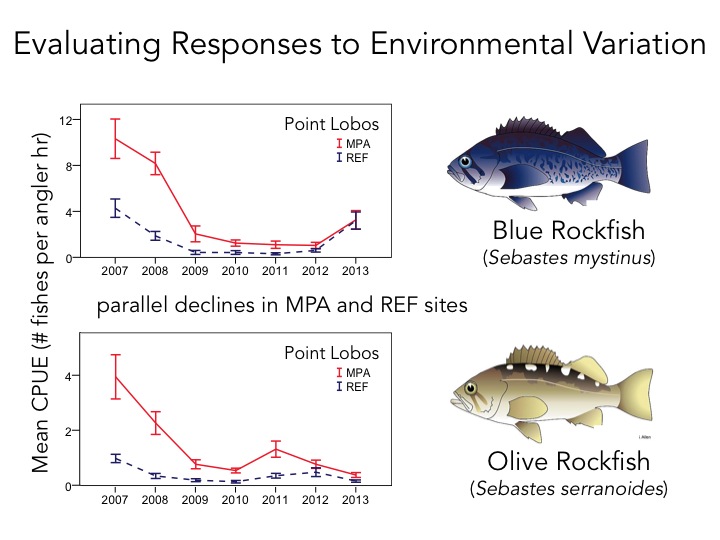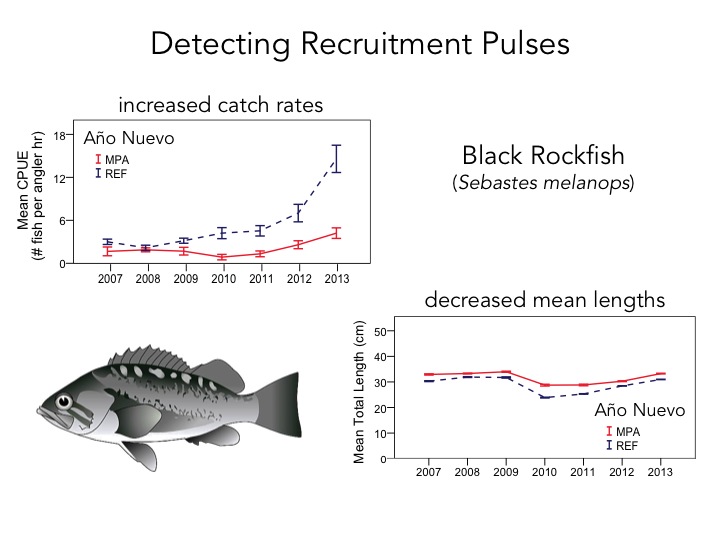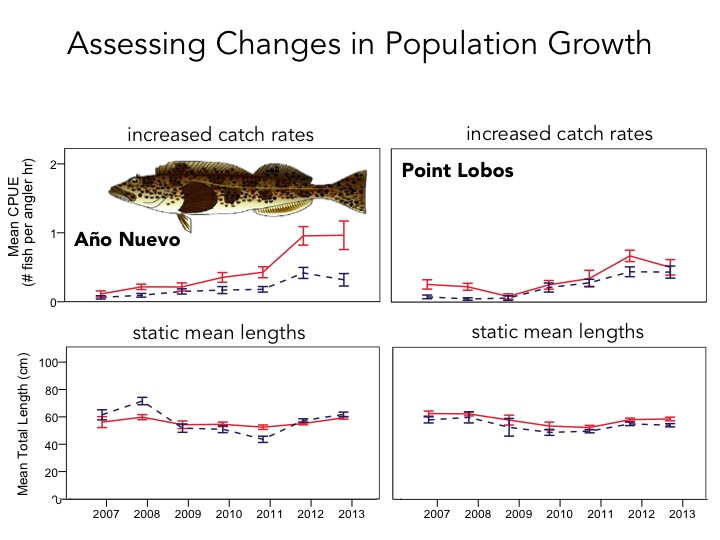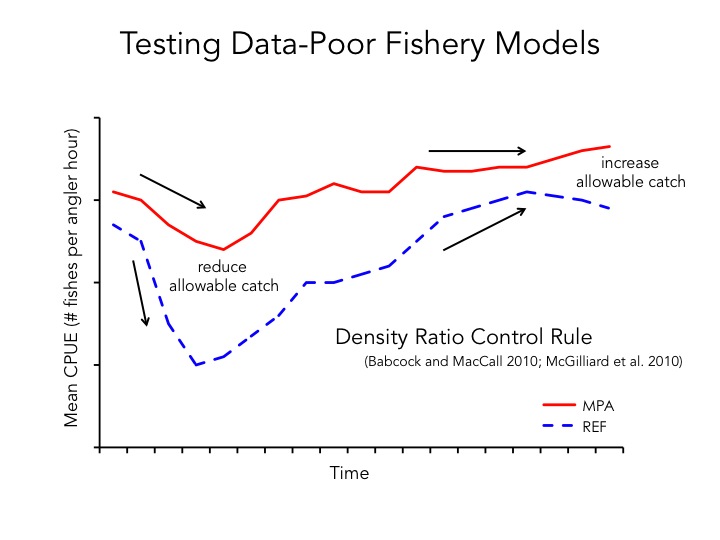How can MPA monitoring inform management?
In addition to monitoring MPA performance, the CCFRP study design enables us to identify population-level responses to environmental variation, pulses in recruitment, and changes in population growth. We can also use CCFRP's long-term data set to test a variety of new, data-poor fishery models to better inform resource managers.
 Figure 1. Using paired MPA/REF sampling techniques, CCFRP has been able to evaluate impacts of environmental variation on the catch rates of nearshore fishes. The figure above shows a stark decline in catch-per-unit-effort (CPUE) of Blue and Olive Rockfish from 2007 to 2009. Because this decline occurred in both the MPA and associated REF sites, we cannot attribute it to fishing pressure. Instead, some environmental factor must have caused this apparent decline.
Figure 1. Using paired MPA/REF sampling techniques, CCFRP has been able to evaluate impacts of environmental variation on the catch rates of nearshore fishes. The figure above shows a stark decline in catch-per-unit-effort (CPUE) of Blue and Olive Rockfish from 2007 to 2009. Because this decline occurred in both the MPA and associated REF sites, we cannot attribute it to fishing pressure. Instead, some environmental factor must have caused this apparent decline.
 Figure 2. CCFRP scientists have been able to combine what we've learned about changes in lengths and catch rates of fishes in order to detect population-level events, such as recruitment. As you can see from the above figure, we started to see an increase in catch-per-unit-effort (CPUE) for Black Rockfish at Año Nueveo in 2009 and 2010. During this same time period, we saw a reduction in the mean length for this species. The combination of increased catch rates (a proxy for density) and decreased mean lengths tells us that there are many more small individuals in the population for this area, hence a recruitment pulse has taken place.
Figure 2. CCFRP scientists have been able to combine what we've learned about changes in lengths and catch rates of fishes in order to detect population-level events, such as recruitment. As you can see from the above figure, we started to see an increase in catch-per-unit-effort (CPUE) for Black Rockfish at Año Nueveo in 2009 and 2010. During this same time period, we saw a reduction in the mean length for this species. The combination of increased catch rates (a proxy for density) and decreased mean lengths tells us that there are many more small individuals in the population for this area, hence a recruitment pulse has taken place.
 Figure 3. CCFRP scientists have been able to combine what we've learned about changes in lengths and catch rates of fishes in order to detect population-level events, such as population growth. As you can see from the above figure, we have seen an increase in catch-per-unit-effort (CPUE) for Lingcod at Año Nueveo and Point Lobos throughout the sampling period. During this same time period, we have seen relatively similar mean lengths for this species. The combination of increased catch rates (a proxy for density) and static mean lengths tells us that there are more individuals of all sizes in the population for these areas, hence overall growth in the Lingcod population is taking place.
Figure 3. CCFRP scientists have been able to combine what we've learned about changes in lengths and catch rates of fishes in order to detect population-level events, such as population growth. As you can see from the above figure, we have seen an increase in catch-per-unit-effort (CPUE) for Lingcod at Año Nueveo and Point Lobos throughout the sampling period. During this same time period, we have seen relatively similar mean lengths for this species. The combination of increased catch rates (a proxy for density) and static mean lengths tells us that there are more individuals of all sizes in the population for these areas, hence overall growth in the Lingcod population is taking place.
 Figure 5. Using CCFRP's long-term data set to test a variety of new, data-poor fishery models allows us to provide information for resource managers to better balance harvest and conservation strategies. One model that we are currently testing utilizes the density ratio control rule, which attempts to keep a catch rates in areas open to fishing proportional to those within corresponding MPAs. When MPA/REF trajectories diverge, resource managers might decide to decrease allowable catch. On the other hand, when these trajectories converge, resource managers might want to increase the allowable catch in areas open to fishing.
Figure 5. Using CCFRP's long-term data set to test a variety of new, data-poor fishery models allows us to provide information for resource managers to better balance harvest and conservation strategies. One model that we are currently testing utilizes the density ratio control rule, which attempts to keep a catch rates in areas open to fishing proportional to those within corresponding MPAs. When MPA/REF trajectories diverge, resource managers might decide to decrease allowable catch. On the other hand, when these trajectories converge, resource managers might want to increase the allowable catch in areas open to fishing.

